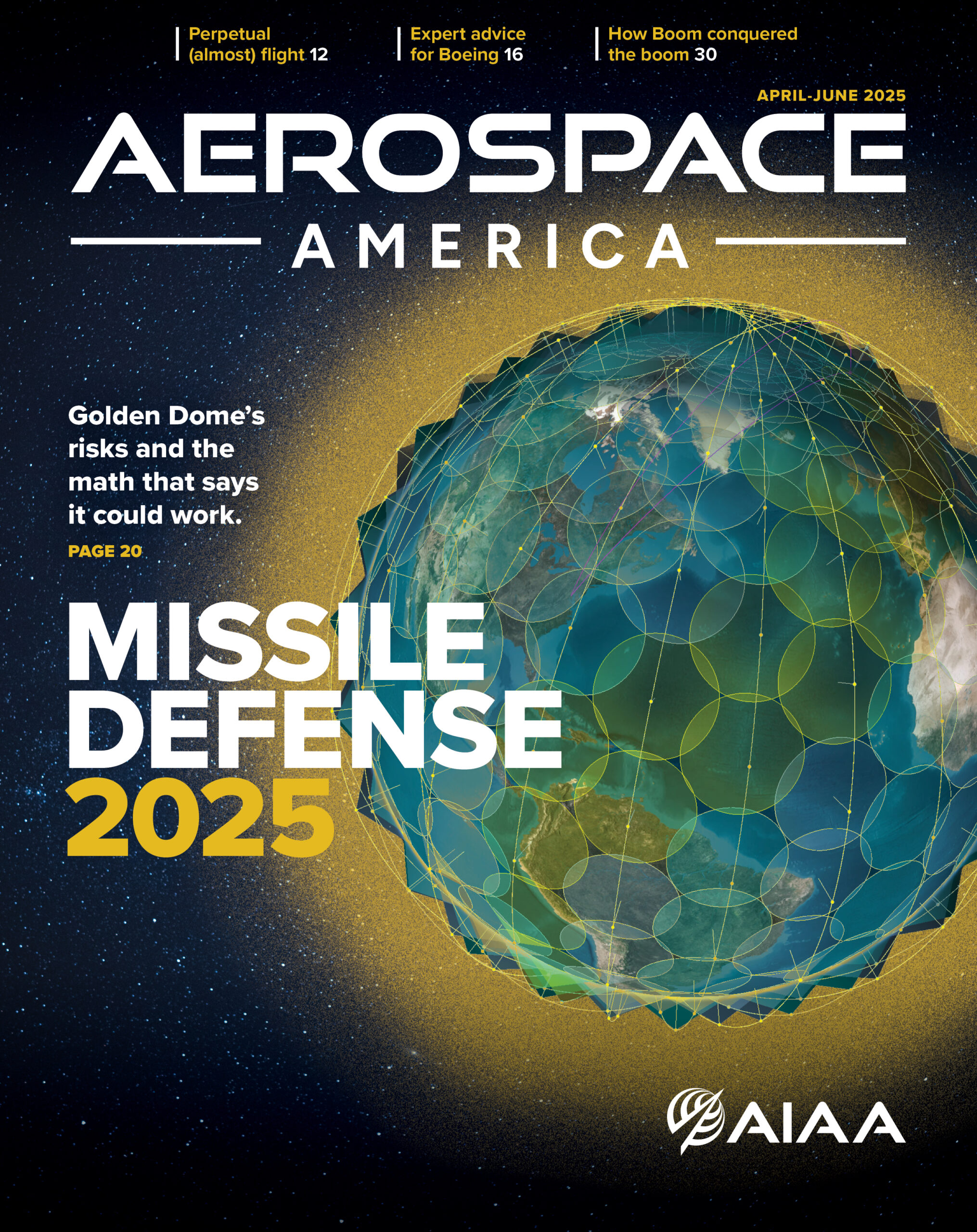In the vast expanse of space, a revolutionary observatory no larger than a small car is quietly transforming our understanding of the cosmos. SPHEREx, NASA’s Spectro-Photometer for the History of the Universe, Epoch of Reionization and Ices Explorer, represents a remarkable achievement in astronomical engineering—a mission that delivers extraordinary science from a deceptively modest package.
As Project Systems Engineer Jennifer Rocca from NASA Jet Propulsion Laboratory (JPL) explains, “We’re really happy to talk about the evolution that brought this mission to life and the observatory that is right now in space taking data that will revolutionize the astronomy community over the next decade.”
Rocca was joined by Instrument Scientist Phil Korngut, Caltech, delivering the annual Pickering Lecture to AIAA’s 2025 ASCEND audience.
A Telescope with Cosmic Ambitions
Launched in March 2025 aboard a SpaceX Falcon 9 rocket, SPHEREx embarks on an audacious quest to answer three of humanity’s most profound questions:
- How did the universe begin?
- How did galaxies form?
- And what are the conditions for life beyond our solar system?
The mission’s elegant simplicity belies its transformative potential—this tiny observatory will create the first all-sky spectroscopic map of the entire celestial sphere.
Unlike previous surveys that captured broadband images, SPHEREx delivers 102 individual wavelengths across the near to mid-infrared spectrum for every 6.2 arc-second pixel on the sky. As Korngut noted, “If the old adage is that a picture is worth 1000 words, a spectrum is really worth 1000 pictures.”
The observatory will generate spectra for approximately 400 million galaxies, providing an unprecedented window into cosmic history at a cost of less than a dollar per galaxy—extraordinary value for such groundbreaking science.
Engineering Marvel in Miniature
Standing just two meters tall, SPHEREx represents a masterpiece of thermal engineering. Operating at an altitude of 650km, where space is relatively warm by astronomical standards, the observatory relies on an ingenious passive cooling system inherited from the Planck mission. Three V-groove radiators beneath the telescope create a geometric cascade effect, allowing heat photons to bounce outward through seven calculated reflections. These radiators extend into massive shrouds that both shield the telescope from unwanted light and maintain cryogenic temperatures without expensive active cooling systems.
“These were really the innovation that enabled SPHEREx to be so low cost,” Rocca explained. “And I think actually are an enabling technology for future missions that want to do cryogenic exploration without a high cost of carrying a cryo cooler.”
The team’s focus on manufacturability proved crucial: “We really wanted to have a simple to build system as well. And so, during development, we actually changed the design from our initial proposal to have solid honeycomb shields that were easier to manufacture.”
The observatory’s three-mirror anastigmat design creates an enormous 11.3 by 3.5-degree field of view, while a dichroic beamsplitter simultaneously directs light to short-wave and mid-wave infrared detectors. The real innovation lies in the linear variable filters (LVFs) overlaying the detector arrays—these filters transmit different wavelengths depending on their position, allowing SPHEREx to build complete spectra by taking sequential pointings across the sky.
As Rocca emphasized, “We literally just use the reaction wheels to point and do every single observation that is planned in the science mission.”
Peering into Cosmic Dawn
SPHEREx addresses fundamental cosmology by studying large-scale structure—the cosmic web of galaxies and voids that traces back to quantum fluctuations in the early universe. According to inflation theory, the entire observable universe was once smaller than an atom, governed by quantum mechanics. As space expanded explosively in the first 10^-32 seconds after the Big Bang, these microscopic density variations stretched to galactic scales, seeding the formation of stars and galaxies.
By measuring spectroscopic redshifts for hundreds of millions of galaxies, SPHEREx will map this large-scale structure with unprecedented precision. The mission also employs intensity mapping techniques to study the extragalactic background light—the integrated glow from all photons emitted since the epoch of reionization, when the first stars ignited in the early universe.
Korngut emphasized the data’s scope: “We use intensity mapping and make these deep maps of this fluctuating light field. And through spectroscopy, we separate out that light field into all of these wavelengths, cross correlate between them, spatially and spectrally.”
The Search for Life’s Building Blocks
Closer to home, SPHEREx investigates the distribution of water ice throughout our galaxy. Since all known life requires water, and most cosmic water exists as ice rather than liquid, the mission surveys millions of sight lines along the galactic plane. Water ice exhibits a distinctive absorption signature at three microns, along with other ices associated with the chemistry of life. This comprehensive galactic survey will reveal how the ingredients for life are distributed throughout our cosmic neighborhood.

Overcoming Extraordinary Challenges
The path to launch proved as complex as the science itself.
The mission concept originated in 2012, enduring multiple proposal cycles and evolving from the Small Explorer to Medium Explorer program. The team persevered through competitive selection processes, design trade studies, and the unprecedented challenges of developing hardware during a global pandemic.
When COVID-19 struck during critical pre-launch testing phases, team members literally took sensitive instruments home to their garages to maintain development momentum.
“We actually had our team take a whole bunch of their hardware to their garages and their home offices, and we kept prototyping during that time,” Rocca recalled.
International collaborations with the Korean Aerospace Research Institute proceeded across the Pacific despite global shutdowns. Korngut reflected on their partners’ remarkable dedication: “Despite … Covid, they delivered this chamber on time. I have no idea how that happened, but it was awesome.”
Supply chain disruptions delayed critical components, while wildfires near JPL forced evacuation routes and threatened team members’ homes even as the observatory traveled to its launch site. “Sadly, at the same time, fires were raging across Altadena, right close to JPL, and we actually had some team members who lost their homes,” Rocca remembered solemnly.
Revolutionary Results Already Emerging
Just months into operations, SPHEREx has demonstrated performance that meets or exceeds all design specifications. The passive cooling system maintains thermal stability to within 10 micro-Kelvin—an extraordinary achievement that enables precise infrared measurements.
Korngut marveled at the system’s precision: “It is stable to an RMS of 10 microkelvin across months. And I can’t wait to make this plot where that x axis goes passive cooling years.” The telescope focuses perfectly, sensitivity matches predictions, and the observatory generates 600 spectroscopic images daily.
Early observations reveal the mission’s transformative potential. Single exposures capture distant galaxies in exquisite spectral detail, while time-lapse sequences show how celestial objects appear dramatically different across wavelengths as various molecular emission lines illuminate different physical processes.
Korngut noted the immediate scientific impact: “We’re already writing initial science papers … There were so many things we just see with our eyeballs in this data coming out, and you’re like, nobody’s ever seen that before.”
Planetary nebulae transform before viewers’ eyes as hydrogen series emissions trace ionization patterns, while polycyclic aromatic hydrocarbons—essentially cosmic diesel exhaust—glow in characteristic spectral signatures.
A Decade of Discovery Ahead
SPHEREx will complete four comprehensive sky maps during its two-year primary mission, with each map offset by half a spectral channel to eliminate systematic errors. The resulting dataset promises to fuel astronomical discovery for decades, much like previous all-sky surveys that continue generating tens of thousands of scientific citations years after completion.
The mission exemplifies how thoughtful engineering and scientific vision can maximize discovery potential within modest budgets. By leveraging innovative thermal design, passive cooling technology, and spectroscopic multiplexing, SPHEREx delivers capabilities previously requiring much larger, more expensive observatories.
As the team proudly noted, the most exciting discoveries will likely emerge from questions no one has yet thought to ask—the hallmark of truly transformative science missions.
In an era of increasingly complex space telescopes, SPHEREx proves that sometimes the most profound insights come from elegant simplicity applied with extraordinary precision.
The William H. Pickering Lecture is named for the former NASA Jet Propulsion Laboratory Director to honor his initiation and leadership of America’s unmanned scientific space program, from Explorer I in 1958 through the development of the Viking orbiters and the Voyager outer planet and interstellar missions.




